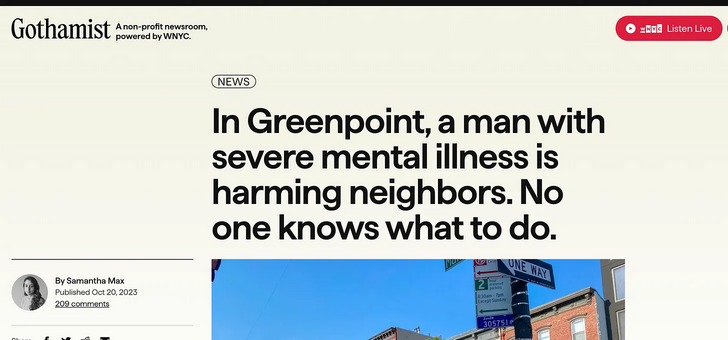But, as Chris Bray illustrates, some people have truly heroic reality-denial complexes going on and they want you to deny reality along with them:
Hey, look, it’s the zeitgeist.
No one knows what to do. About this:
Court records show the man who pushed Whitcomb currently faces charges ranging from harassment and menacing to assault and illegal possession of a knife. He has also been accused of groping and assaulting women on the north side of the neighborhood and is on the state’s sex offender registry for forcible touching and sexual abuse convictions in 2017 and 2021.
He hurts people a lot, and he’s a registered sex offender, and he sometimes carries a knife, and he walks up to strangers on the street and just hurts them for no reason, and he especially likes to hurt women quite a lot, especially in ways that seem pretty consistently sexual. It’s … complicated. Hard to know what to do!
Note that the story takes care to avoid identifying the person the story is about, because the reporter is concerned that identifying the serial aggressor will make it possible for someone to hurt him: “Gothamist has chosen to withhold the man’s name because of his mental illness and because he is at risk of additional attacks by people who want to take matters into their own hands”. And hurting people is wrong. To prevent attacks, see, you don’t tell people the name of a person who keeps … attacking.
The story warns that the constant aggression of [unnamed person] is a warning about “the systemic failures that allow people to fall through the cracks,” because what a man hurting people over and over again shows us is that the man who’s being forced to hurt all those people by society’s deep cruelty isn’t getting enough services. Greenpoint, an increasingly expensive neighborhood in Brooklyn, is represented by “some of the city’s most progressive lawmakers”, but they’re still struggling with these hard questions. America in 2023, ladies and gentlemen.
But finally, as a test of the reporter’s good faith, we get a broader description that contextualizes the problem. There are a lot of people in New York City who are being forced to hurt other people because they aren’t being given enough services, and here comes a famous example: “Earlier this year, Daniel Penny fatally choked Jordan Neely, a beloved Michael Jackson impersonator who Penny said was ‘going crazy’ and acting aggressively toward fellow subway riders.”
That’s it — that’s the whole description. Who was Jordan Neely? He was a man who impersonated Michael Jackson, and he was loved a whole lot, but then for some unaccountable reason Daniel Penny claimed the beloved man was going crazy, so he just suddenly killed the poor man. It’s strange that this Penny person would say something like that, right?
Now, in a city of eight million people, Jordan Neely was on a list, kept by the city government, of the fifty homeless people whose behavior is most persistently troubling. His case was regularly monitored by the “Coordinated Behavioral Health Task Force”, which “consists of workers from across city government, including the departments of Health, Homeless Services and Hospitals, along with representatives of the nonprofits that the city contracts with to try to connect homeless people to shelter and services, a process known as outreach”. At the time when the mean Daniel Penny suddenly killed him for no reason, Neely had an active arrest warrant. And other passengers in the subway car said that — well, let’s turn to the headline in the New York Times: “Witnesses in Subway Chokehold Case Describe Fears of Death and Violence“.




